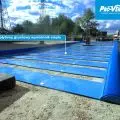The Wozownia Art Gallery invites you to the summer with architecture - ArchiLATO. This is a series of lectures taking place online. The first one entitled: "Houses like ships. Streamlined Moderne Architecture in the Kuyavian-PomeranianVoivodeship" will be held on Tuesday, July 28. It will be delivered by Dr. Michał Pszczółkowski.
The lecture by Dr. hab. Michal Pszczółkowski will be on the architecture of the 20-yearinterwar period in the region and examples of the occurrence in it of the so-called ship style. The lecture will take place on July 28 at 18:30 online - streaming will be conducted on the YouTube channel of theWozownia Art Gallery.
Modern liners like the French Normandy, British Queen Mary or German Bremen fascinated with their structural logic, solidity and simplicity, going hand in hand with the modernist slogan of form resulting from function
photo by Michal Pszczolkowski
"front to the sea"
The interwar years and the associated promotion of a new lifestyle - the modern homo viator, fostered the development of communications. The symbols of progress of the 1920s and 1930s became the automobile, the airplane and especially the transatlantic liner. Modern liners like the French Normandie, the British Queen Mary or the German Bremen fascinated with their structural logic, solidity and simplicity, going hand in hand with the modernist slogan of form resulting from function. Streamlined forms set new trends in design, and were not without influence on architectural designers either. Thus was born the streamlined moderne trend - "ship style".
This direction found fertile ground in Poland, after all, the maritime economy was an extremely important element in building the power of the reborn state. In the then Pomeranian voivodeship - with a strategic geographic location, because it was the only one with access to the sea - "maritime Poland" and the popular slogan "front to the sea" were particularly manifested in visual form . Buildings with streamlined moderne features can be found in Bydgoszcz, Toruń, Inowrocław, Brodnica and many other cities of today's Kuyavian-Pomeranian region. They are distinguished by flat roofs with terraces shaped on several levels, rounded edges of balconies, often encompassing corners, and semicircular risalits with terraces. The facades and door frames often feature portholes - symbolic windows to the sea and Pomerania. These very realizations will be the subject of the lecture.
They are distinguished by flat roofs with terraces shaped on several levels, rounded edges of balconies, often encompassing corners, and semicircular risalits with terraces
Photo by Michal Pszczolkowski
Michal Pszczolkowski - PhD, professor at the Academy of Fine Arts in Gdansk. In 2005 he graduated from the Faculty of Fine Arts at the Nicolaus Copernicus University in Torun. He also studied in Oldenburg and Bamberg. In 2010, he received his doctorate in art sciences, and in 2018 he received his habilitation from the Faculty of Architecture at Gdansk University of Technology. As of 2019, he is employed as a professor at the Academy of Fine Arts in Gdansk. A scholarship holder of the Foundation for Polish Science in Warsaw and the Ministry of Culture and National Heritage, he is a member of the Association of Art Historians (since 2018 President of the Board of the Toruń Branch) and the Society for the Care of Monuments. Michal Pszczółkowski's research interests focus on the history of architecture, especially modern architecture (20th century). Among other things, he has published more than a dozen scientific monographs.






















